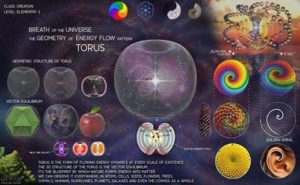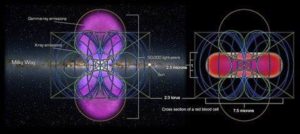Proton + Quarks
“Even just protons, something previously thought impossible” + Miracle is a Proton 99.9999% Energy + Proton + Proton = Expand + “Every Proton has the same information” from Proof #1518 + Miracles in Quantum Mechanics
Physicists Create Incredible ‘Quark Soup’ Droplets That Expand Like Little Big Bangs
Scientists at the Large Hadron Collider in Geneva, Switzerland and the Relativistic Heavy Ion Collider (RHIC) at Brookhaven National Laboratory have been producing this liquid for a decade by colliding atomic nuclei. But more surprisingly, evidence is beginning to mount that they can create this quark-gluon plasma with smaller systems, even just protons, something previously thought impossible. A new study from scientists at RHIC’s PHENIX experiment is the next step in understanding this strange fluid and how it forms. https://gizmodo.com/physicists-create-incredible-quark-soup-droplets-that-e-1830992693?fbclid=IwAR0G27Jq_dtj8hYxK2lzSfAX7LTxjLsAtB2QsYfrN1FnqVKNR6GEL1Z13zM
Nerdvana
MMMMMMMMMMMM. Quarks with Zweig and Gell-Mann
Named by: Murray Gell-Mann, 1963
Cheese Curds
Quarks are elementary particles that form hadrons such as protons and neutrons, as well as more exotic particles and states of matter like quark-gluon plasma. They were proposed simultaneously by Murray Gell-Mann and George Zweig (who wanted to call them “aces”), and different types of quarks were discovered throughout the rest of the 20th century by multiple different teams of physicists.
Gell-Man wrote about the name in his popular science book The Quark and the Jaguar:
In 1963, when I assigned the name “quark” to the fundamental constituents of the nucleon, I had the sound first, without the spelling, which could have been “kwork.” Then, in one of my occasional perusals of Finnegans Wake, by James Joyce, I came across the word “quark” in the phrase “Three quarks for Muster Mark”.
Since “quark” (meaning, for one thing, the cry of the gull) was clearly intended to rhyme with “Mark,” as well as “bark” and other such words, I had to find an excuse to pronounce it as “kwork.” But the book represents the dream of a publican named Humphrey Chimpden Earwicker. Words in the text are typically drawn from several sources at once, like the “portmanteau” words in Through the Looking-Glass. From time to time, phrases occur in the book that are partially determined by calls for drinks at the bar.
I argued, therefore, that perhaps one of the multiple sources of the cry “Three quarks for Muster Mark” might be “Three quarts for Mister Mark,” in which case the pronunciation “kwork” would not be totally unjustified. In any case, the number three fitted perfectly the way quarks occur in nature.
Some scholars suspect that the quark in Joyce’s epic derives from the German quark, which is a type of cheese curd. The German quark is likely taken from West Slavic words meaning “to form”—potentially a reference to milk solidifying and becoming curd. Serendipitously, “to form” is also the non-dairy quark’s role as the main constituent of matter.
Physicists have discovered six types of quarks, named “up,” “down,” “strange,” “charm,” “top” and “bottom.”
up and down quarks: Gell-Mann named these quarks in 1964 for their upward and downward isospin, which is a quantum property of particles related to the strong nuclear force.
strange: Unlike up and down quarks, strange quarks were observed before the quark model was developed, as constituents of composite particles called kaons. These particles were deemed “strange” because they had unusually long lifetimes, due to some of their decays occurring through the weak force. Gell-Man called them “strange” quarks in 1964.
charm: The charm quark was predicted in a paper by two physicists, Sheldon Glashow and James Bjorken, in 1964. As they explained in a New York Times article: “We called our construct the ‘charmed quark,’ for we were fascinated and pleased by the symmetry it brought to the subnuclear world.” “Charm,” meaning “pleasing quality,” is derived from the Latin carmen, “song, verse, enchantment.”
top and bottom: Physicists Makoto Kobayashi and Toshihide Maskawa predicted the existence of the last two quarks in 1973, but they did not assign names to the new particles. Many scientists unofficially called them “truth” and “beauty.”
In a 1975 paper, physicist Haim Harari gave them names that stuck. To preserve the initials “t” and “b” and create a fitting counterpart for up and down quarks, Harari called them “top” and “bottom” quarks.
A brief etymology of Particle Physics
https://www.symmetrymagazine.org/article/a-brief-etymology-of-particle-physics?utm_content=buffer9a8c8&utm_medium=social&utm_source=facebook.com&utm_campaign=buffer
From Quarks to Quasars, the most foundational energy flow structure in the universe: Torus
The galaxy and red blood cells each have the same fundamental structure: Torus
Image: we-can.be
Image: Welcome to the Golden PAge
The Resonance Project
Named by: unclear
Neutrons are particles made of up and down quarks. According to a letter published in Nature, it is unclear whether physicist William Harkins or physicist Ernest Rutherford referred to the electrically neutral nucleon as a “neutron” first. What is clear is that both came up with the same name for the same particle in 1921, likely drawing on the same etymology of the root word “neutral.”
A brief etymology of Particle Physics
https://www.symmetrymagazine.org/article/a-brief-etymology-of-particle-physics?utm_content=buffer9a8c8&utm_medium=social&utm_source=facebook.com&utm_campaign=buffer
A new system of five particles all in a single analysis has been discovered, with the help of The Large Hadron Collider beauty experiment (LHCb).
These particle states are named, according to the standard convention, Ωc(3000)0, Ωc(3050)0, Ωc(3066)0, Ωc(3090)0 and Ωc(3119)0. All these particles were found to be excited states of Omega-c-zero, a particle with three quarks.
The work that is needed, is to find the quantum number and theoretical consequence of these new particles. This will all add to our understanding of the correlation between quarks, and multi-quark states, which will further the way we comprehend our universe and quantum theory in general.
CERN called this “a hotbed of new and outstanding physics results.” And it’s just the beginning because more experiments and results are on their way.


Comments